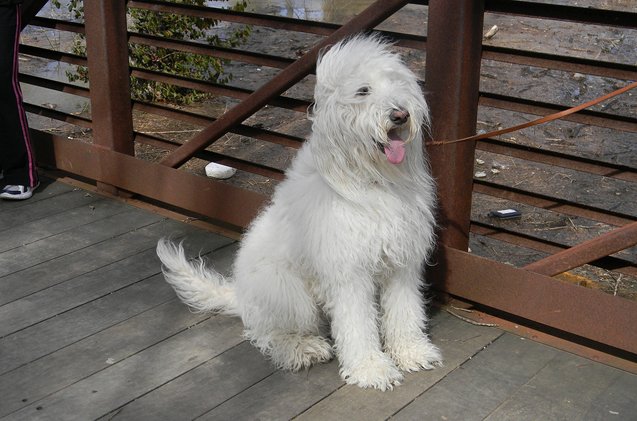Pyredoodle


About Pyredoodle
The Pyredoodle is a mix of Standard Poodle and Great Pyrenees and it makes for a terrific dog that plays well with kids and other animals alike. Because he has a protective nature he makes a great watchdog whose bark is worse than his bite. Because of his size, he needs regular rigorous exercise and that should include active playtime.
The Pyredoodle is a mix of Standard Poodle and Great Pyrenees that makes a great family dog.
Pyredoodles are a Designer Dog and likely originated back in the 1980s when breeders incorporated Poodles to produce low- or non-shedding variations of popular breeds. Though he’s relatively new, his lineage includes the Standard Poodle which dates back to 16th century Germany and the Great Pyrenees who goes back to the early 17th century where he was used to guard sheep in the Pyrenees Mountains between France and Spain.
Because of his designer status, the Pyredoodle is not eligible to join the American Kennel Club’s (AKC) roster of purebreds however both parents are members. The Standard Poodle joined the “sporting group” back in 1887 and the Great Pyrenees became a member of the club’s “working” group in 1933.
Pyredoodles are a large dog and because they have a tendency to become obese, their diet needs to include a high-quality protein-rich kibble without fillers (carbs) that will cause them to overeat to feel full. Kibble format should be large to prevent gobbling and he should be fed at specific meal periods rather than free-fed. He can be prone to joint issues later in life so keeping him fit and trim through a healthy diet is crucial.
The Pyredoodle is a loyal family dog that is highly intelligent.
In spite of his larger size, this sweet natured dog can be quite timid; a characteristic he won’t necessarily grow out of. Because you want him to be comfortable around people and other animals it’s important that socialization begin at an early age. His intelligence and easy temperament make him fairly easy to train but he can be a little stubborn so a firm, consistent approach is best. Training should always be rewards-based with lots of verbal praise and treats or pats offered up as an incentive.
The Pyredoodle is a large sized breed and will weigh between 85 and 100 pounds.
The Pyredoodle is a loyal family dog that is highly intelligent, great with children and in spite of his sweet-natured personality, quite protective of his human pack so potentially a good watchdog. This pooch does have a keen-to-please personality which makes him fairly easy to train and because he tends to be timid, early socialization is important. In spite of his large size, he is a wonderfully calm dog when indoors and he loves to be the center of attention.
Designer dogs are often bred specifically to by-pass the health issues that plague their pure-bred parents, so your Pyrador will likely be quite healthy. However it’s important to know what your pooch could inherit. With the Pyredoodle, this could mean medical issues such as bloat and digestive issues, Cushings as well as certain cancers
The Pyredoodle has a life expectancy of 10 to 12 years.
While your Pyredoodle is a big boy he also tends to be on the lazy side so he’ll need one good walk each day to prevent him from putting on weight plus some interactive playtime to keep him mentally stimulated and out of trouble. He has a high tendency to wander so leash-free dog parks may not be the best fit for him. Because he can be susceptible to bloat, don’t schedule his activity sessions around his meals.
The Pyredoodle has a keen-to-please personality which makes him fairly easy to train.
Also known as a Pyrepoo, Pyreneesdoodle and Pyreneespoo, the Pyredoodle is not recognized by the American Kennel Club however is a member of the Dog Registry of America, Inc. (DRA), American Canine Hybrid Club (ACHC) and Designer Dogs Kennel Club (DDKC)
The Pyredoodle’s coat can vary dramatically depending on which breed he leans towards. From a long, thick double-coat to a short, dense single-coat it all depends on which side of the gene pool your pup comes from. As a result, grooming can range from a necessary daily brushing to just twice weekly if he has the lower-shedding poodle coat. Either way, this dog is a low- to moderate- shedder who may (or may not) have a hypoallergenic coat. Floppy ears mean weekly ear inspection and cleaning to avoid wax build-up and infection.
Your Pyredoodle puppy is going to be a large dog and because of his rapid growth you will need to heed his dietary needs. Don’t plan to free-feed him or provide foods that are high-energy (calories) or high-calcium because it can result in orthopaedic diseases common in larger, fast-growing dogs. Because he can be prone to joint issues later in life, take it easy on the exercise while he is young. Never over-exert him as this type of injury can plague him as he ages.
Photo credit: dc54/Bigstock; otsphoto/Bigstock; eriklam/Bigstock

Sharing space with three seriously judgy Schnoodles and a feline who prefers to be left alone. #LivingMyBestLife
More by Mary Simpson

























